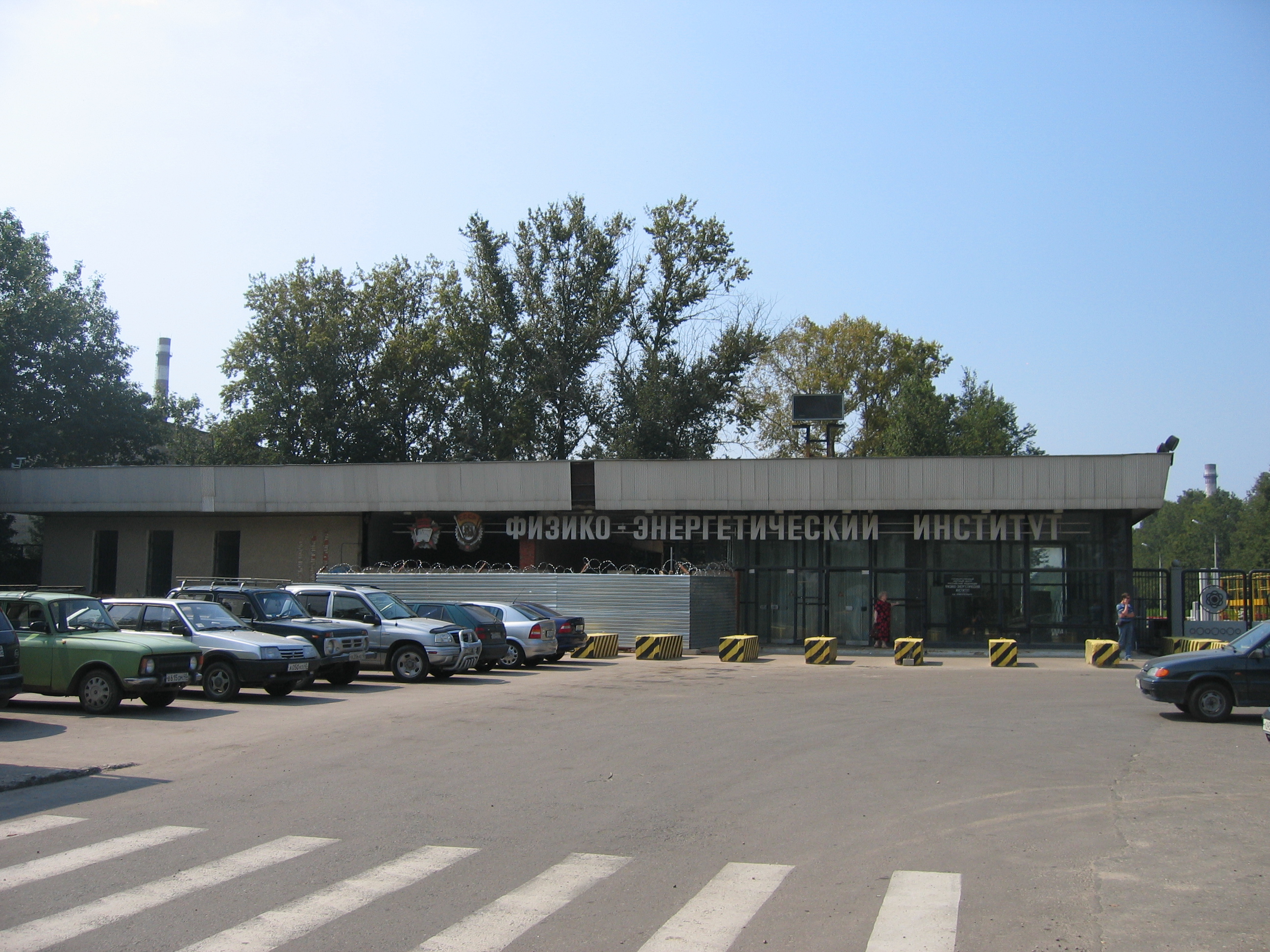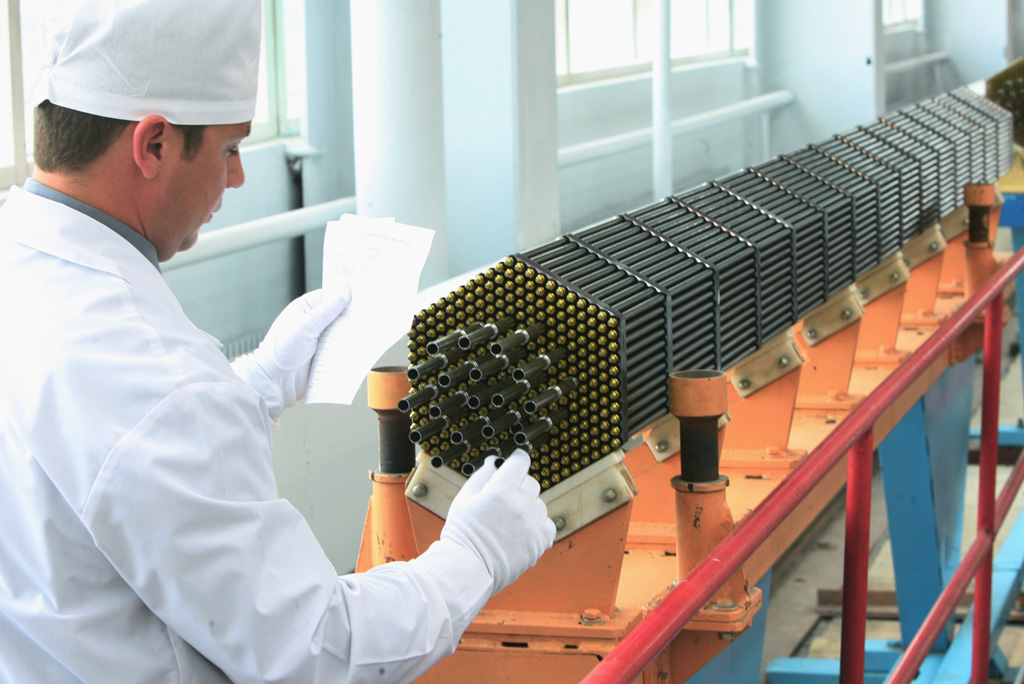|
IPPE
Institute of Physics and Power Engineering (full name: I.I. Leypunsky Institute of Physics and Power Engineering, russian: –У–Њ—Б—Г–і–∞—А—Б—В–≤–µ–љ–љ—Л–є –љ–∞—Г—З–љ—Л–є —Ж–µ–љ—В—А –†–Њ—Б—Б–Є–є—Б–Ї–Њ–є –§–µ–і–µ—А–∞—Ж–Є–Є –§–Є–Ј–Є–Ї–Њ-—Н–љ–µ—А–≥–µ—В–Є—З–µ—Б–Ї–Є–є –Є–љ—Б—В–Є—В—Г—В, –У–Э–¶ –†–§-–§–≠–Ш; IPPE) is a research and development institute in the field of nuclear technology located in Obninsk, Russia. It is a subsidiary of Rosatom. History IPPE was established in May 1946 to develop nuclear power technology; it was preceded by First Research Institute Laboratory "V", established 1945, which developed into IPPE. The purpose of the Institute was the development of nuclear reactors and to solve scientific and engineering tasks in the field of nuclear power. The staff of the Institute had built the world's first nuclear power plant in Obninsk, AM-1 ("–Р—В–Њ–Љ –Ь–Є—А–љ—Л–є", Russian for Atom Mirny, or "peaceful atom"), was commissioned at IPPE on 27 June 1954. Developments During i ... [...More Info...] [...Related Items...] OR: [Wikipedia] [Google] [Baidu] |
OKBM
OKBM Afrikantov (full name: OAO I. I. Afrikantov OKB Mechanical Engineering, russian: –Ю–њ—Л—В–љ–Њ–µ –Ї–Њ–љ—Б—В—А—Г–Ї—В–Њ—А—Б–Ї–Њ–µ –±—О—А–Њ –Љ–∞—И–Є–љ–Њ—Б—В—А–Њ–µ–љ–Є—П –Є–Љ. –Ш. –Ш. –Р—Д—А–Є–Ї–∞–љ—В–Њ–≤–∞) is a nuclear engineering company located in Nizhny Novgorod, Russia. It is a subsidiary of Rosatom. The company is named after Igor Afrikantov. The company is best known as the main designer for the Soviet Union's and Russia's flagship nuclear propulsion projects, including reactors for nuclear submarines, nuclear-powered icebreakers, and the floating nuclear power plant project. It also designs fast breeder reactors. History The company was founded in 1945. In 1998, it was named after its former chief designer and director I. I. Afrikantov. Products The company is a developer of the nuclear reactors. It has designed and assembled KLT-40S reactors for the first Russian floating nuclear power station ''Akademik Lomonosov''. It also developed the RITM-200 d ... [...More Info...] [...Related Items...] OR: [Wikipedia] [Google] [Baidu] |
BN-350 Reactor
The BN-350 is a sodium-cooled, fast reactor located at the ''Mangyshlak Nuclear Power Plant'', located in Aktau (formerly known as Shevchenko under the control of the USSR in 1964вАУ1992), Kazakhstan, on the shore of the Caspian Sea. Construction of the BN-350 fast breeder reactor began in 1964, and the plant first produced electricity in 1973. In addition to providing power for the city (350 MWe), BN-350 was also used for producing plutonium and for desalination to supply fresh water (120,000 m¬≥ fresh water/day) to the city. Planning and design The prototypes for the development of the BN-350 reactor were the experimental reactor BR-5 , built in 1959 on the territory of the Institute of Physics and Power Engineering (IPPE, Obninsk, Kaluga region ), and the research reactor BOR-60 , introduced at RIAR in 1969. (Melekess, now Dimitrovgrad , Ulyanovsk region ) . The development of all power reactors was carried out under the scientific guidance of IPPE. A three-circuit react ... [...More Info...] [...Related Items...] OR: [Wikipedia] [Google] [Baidu] |
BM-40A Reactor
The BM-40A reactor is the nuclear fission reactor used to power four of the seven boats of the Soviet Navy's Project 705 –Ы–Є—А–∞ (Lira or Alfa in NATO designation) fourth generation submarines. It is a liquid metal cooled reactor (LMR), using highly enriched uranium-235 fuel to produce 155 MWt of power. It was developed by OKB Gidropress in cooperation with IPPE. ''BM-40A'' has two steam circulation loops. See also * OK-550 reactor External links Project 705 Lira Alfa class at the Federation of American Scientists The Federation of American Scientists (FAS) is an American nonprofit global policy think tank with the stated intent of using science and scientific analysis to attempt to make the world more secure. FAS was founded in 1946 by scientists who w ... website. Lead-bismuth cooled reactor plants for nuclear submarinesat the Gidropress website. Soviet naval reactors Liquid metal fast reactors {{nuclear-energy-stub ... [...More Info...] [...Related Items...] OR: [Wikipedia] [Google] [Baidu] |
Obninsk
Obninsk (russian: –ЮћБ–±–љ–Є–љ—Б–Ї) is a city in Kaluga Oblast, Russia, located on the bank of the Protva River southwest of Moscow and northeast of Kaluga. Population: History The history of Obninsk began in 1945 when the First Research Institute Laboratory "V", which later became known as IPPE (Institute of Physics and Power Engineering) was founded. On June 27, 1954, Obninsk started operations of the world's first nuclear power plant to generate electricity for a power grid. The city was built next to the plant in order to support it. Scientists, engineers, construction workers, teachers and other professionals moved to Obninsk from all over the Soviet Union. Town status was granted to Obninsk on June 24, 1956. The name of the city is taken from Obninskoye, the train station in Moscow-Bryansk railroad, built in Tsarist times. Obninskoye and Obninsk were the frontline edges of the White/Red Armies in 1917-1924, also the 1812 War with France and the 1941-1942 Battle of Mosco ... [...More Info...] [...Related Items...] OR: [Wikipedia] [Google] [Baidu] |
Rosatom
Rosatom, ( rus, –†–Њ—Б–∞—В–Њ–Љ, p=r…РsЋИat…Щm}) also known as Rosatom State Nuclear Energy Corporation, the State Atomic Energy Corporation Rosatom or Rosatom State Corporation, is a Russian state corporation headquartered in Moscow that specializes in nuclear energy, nuclear non-energy goods and high-tech products. Established in 2007, the organization comprises more than 350 enterprises, including scientific research organizations, the nuclear weapons complex, and the world's only nuclear icebreaker fleet. The state corporation is one of the largest in the world's nuclear energy industry. The organization ranks first as the largest electricity generating company in Russia, producing 215.746¬†TWh of electricity, 20.28%¬†of the country's total electricity production. The corporation also ranks first in the overseas NPP construction, responsible for 76% of global nuclear technology exports:¬†35¬†nuclear power plant units, at different stages of development, in 12 countries, as of ... [...More Info...] [...Related Items...] OR: [Wikipedia] [Google] [Baidu] |
VT-1 Reactor
The VT-1 reactor was the nuclear fission reactor used in a pair to power the as part of the Soviet Navy's Project 645 –Ъ–Є—В-–Ц–Ь–Ґ. It is a liquid metal cooled reactor (LMR), using highly enriched uranium-235 fuel to produce 73 MW of power. ''K-27'' was a first generation nuclear submarine, and the only one of its class fitted with liquid metal cooled reactors. However the seven-member were subsequently fitted with liquid metal cooled reactors. It was developed by OKB Gidropress in cooperation with IPPE. See also * United States Naval reactors * Naval Reactors Naval Reactors (NR), also known as the Naval Nuclear Propulsion Program, is an umbrella term for the U.S. government office that has comprehensive responsibility for the safe and reliable operation of the United States Navy's nuclear propulsion p ... Soviet naval reactors Liquid metal fast reactors {{Nuclear-energy-stub ... [...More Info...] [...Related Items...] OR: [Wikipedia] [Google] [Baidu] |
TOPAZ Nuclear Reactor
The TOPAZ nuclear reactor is a lightweight nuclear reactor developed for long term space use by the Soviet Union. Cooled by liquid metal, it uses a high-temperature moderator containing hydrogen and highly enriched fuel and produces electricity using a thermionic converter. Nomenclature In initial discussions, it was unclear that TOPAZ and the somewhat similar YENISEI reactors were different systems, and when the existence of the two Russian thermionic reactors became generally known, US personnel began referring to TOPAZ as TOPAZ-I and YENISEI as TOPAZ-II. TOPAZ-I The first thermionic converter reactors were discussed by scientists at the Los Alamos Scientific Laboratory (LASL) in 1957. Following the visit of Soviet scientists to LASL in 1958, they carried out tests on TI systems in 1961, initially developing the single cell ENISY reactor (also known as TOPAZ-II). Work was carried out by the Kurchatov Institute of Atomic Energy and the Central Bureau for Machine Building to dev ... [...More Info...] [...Related Items...] OR: [Wikipedia] [Google] [Baidu] |
Liquid Metal Cooled Reactor
A liquid metal cooled nuclear reactor, liquid metal fast reactor or LMFR is an advanced type of nuclear reactor where the primary coolant is a liquid metal. Liquid metal cooled reactors were first adapted for nuclear submarine use and have been studied for power generation applications. Metal coolants remove heat more rapidly and allow much higher power density. This makes them attractive in situations where size and weight are at a premium, like on ships and submarines. To improve cooling with water, most reactor designs are highly pressurized to raise the boiling point, which presents safety and maintenance issues that liquid metal designs lack. Additionally, the high temperature of the liquid metal can be used to produce vapour at higher temperature than in a water cooled reactor, leading to a higher thermodynamic efficiency. This makes them attractive for improving power output in conventional nuclear power plants. Liquid metals, being electrically highly conductive, can be m ... [...More Info...] [...Related Items...] OR: [Wikipedia] [Google] [Baidu] |
International Science And Technology Center
The International Science and Technology Center (ISTC) is an intergovernmental nonproliferation organization connecting scientists with their peers and research organizations in other countries. The ISTC Headquarters is currently in Nur Sultan, Kazakhstan. Member governments have included Armenia, the European Union, Georgia, Japan, Kazakhstan, the Republic of Korea, Kyrgyzstan, Norway, Tajikistan, and the United States. Scientists from nearly 60 countries have participated in ISTC activities. ISTC facilitates international science projects and assists the global scientific and business community to source and engage scientists and institutes that develop or possess an excellence of scientific know-how. History The ISTC was established in 1992. Its headquarters were originally in Moscow. In 2015, the ISTC moved to Astana Astana, previously known as Akmolinsk, Tselinograd, Akmola, and most recently Nur-Sultan, is the capital city of Kazakhstan. The city lies on the banks of ... [...More Info...] [...Related Items...] OR: [Wikipedia] [Google] [Baidu] |
OK-550 Reactor
The OK-550 reactor is the nuclear fission reactor used to power three of the seven boats of the Soviet Navy's Project 705 –Ы–Є—А–∞ (Lira or Alfa in NATO designation) fourth generation submarines. It is a liquid metal cooled reactor (LMR), using highly enriched uranium-235 fuel to produce 155 MWt of power. ''OK-550'' has three separate steam circulation loops, and was used in the boats built at Severodvinsk. The reactor was developed by OKBM OKBM Afrikantov (full name: OAO I. I. Afrikantov OKB Mechanical Engineering, russian: –Ю–њ—Л—В–љ–Њ–µ –Ї–Њ–љ—Б—В—А—Г–Ї—В–Њ—А—Б–Ї–Њ–µ –±—О—А–Њ –Љ–∞—И–Є–љ–Њ—Б—В—А–Њ–µ–љ–Є—П –Є–Љ. –Ш. –Ш. –Р—Д—А–Є–Ї–∞–љ—В–Њ–≤–∞) is a nuclear engineering com .... See also * BM-40A reactor External links Project 705 Lira Alfa classat the Federation of American Scientists website. Soviet naval reactors Liquid metal fast reactors {{nuclear-energy-stub ... [...More Info...] [...Related Items...] OR: [Wikipedia] [Google] [Baidu] |



